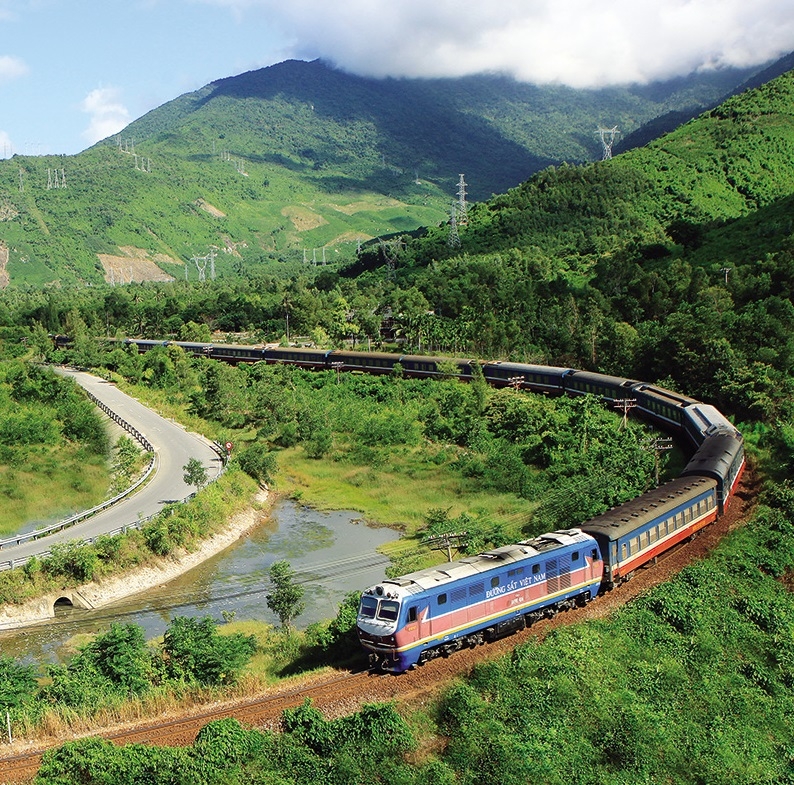Vietnam Railways signals for growth
 |
| State-owned Vietnam Railways currently controls all rail lines across the country |
This week representatives of state-owned railway giant Vietnam Railways (VNR), which operate all railway lines in the country, visit China to work on a new partnership model, pinning high hopes of making positive changes in its future operations.
The visit follows a memorandum of understanding (MoU) late last week signed between VNR and a Chinese company, which is expected to make investment in Vietnam in train manufacturing, employing Vietnamese labourers, raw materials, and infrastructure. Trains will then be leased by VNR for about 10-15 years before taking ownership of them.
“This new partnership is an effective tool for Vietnam’s railway sector to develop amid limited capital for transport infrastructure development,” said Vu Anh Minh, VNR chairman. “As proven, train manufacturing is costly while its maintenance cost is huge. Thus, the partnership is expected to help us cut financial and maintenance costs, and improve capacity of the mechanical railway industry to meet demands of the domestic market.”
Also last week, VNR worked with AREP, a subsidiary of the French National Railway Company (SNCF), a world-leader in high-speed rail, on the possibilities of co-operating in investment in development of rail infrastructure, including railway stations.
VNR’s new moves show its positive mindset towards the market orientation by boosting co-operation with the private sector and international partners in order to tap into growing transportation demands, driven by regional growing trade. The railway corporation is now waiting for the completion of some regulatory frameworks to take the next steps with the French company.
Decree No.46/2018/ND-CP dated March 14, 2018 on management, use and operation of national railway infrastructure, is considered groundbreaking for the railway sector and for VNR, which has for years been the only manager and operator of state-owned national railway assets.
Accordingly, under Decree 46, national railway infrastructure assets are divided into two categories. The first is the assets directly used for train operation such as railways, bridges, tunnels, and rails. The second is the assets indirectly used for train operation such as the station square, warehouses, inland container depots (ICDs), and service and training facilities. The assets indirectly used for train operation will be handed over to VNR to own, use, and develop the equivalent state capital.
The move will enable the giant to take the initiative with its investment plans and to be looked upon more favourably when calling for private investment in upgrading stations and logistics facilities, and developing stations that enjoy commercial advantages.
“For the assets indirectly used for train operation, the railway operator plans to co-operate with other funders to invest in developing ICDs and warehouses along the railway network from Song Than Station in the southern province of Binh Duong, to Dong Anh Station in Hanoi, and then to Lao Cai and Dong Dang to increase transportation capacity,” Minh added.
The opportunities for domestic and foreign private investors will increase when VNR dumps its monopoly in cargo transport by merging with Hanoi Railway Transport JSC and Saigon Railway Transport JSC into one joint stock company, due to take place next year. The new company would then be split into two, with one part specialising in passengers, in which VNR would hold a controlling stake, and another part focusing on cargo transport with VNR possibly divesting the stake.
The Vietnamese railway industry, with 2018 revenues estimated to have risen by 8-10 per cent on-year, has been attracting growing interest among international investors from the likes of Japan, France, China, Germany, and the US, who are all seeking business opportunities in anticipation of huge future demands to upgrade and develop the system.
Currently, the ASEAN represents a market of about 650 million people and a regional GDP of over $2.4 trillion. Intra-ASEAN trade is about a quarter of the ASEAN’s total trade. The bloc is now Vietnam’s fourth-biggest export market behind the EU, the US, and China.
According to the General Statistics Office, Vietnam’s export turnover to the ASEAN region was $21.7 billion in 2017, up 24.5 per cent on-year, and increased to $24.7 billion last year. The figure hit 8.4 billion in the first four months of 2019, up 7.3 per cent on-year.
However, Vietnam’s downgraded railway network, which currently connects to international markets via the Haiphong-Lao Cai and the Hanoi-Lang Son routes, fails to meet the potential due to undeveloped infrastructure. Thus, upgrades are required in order to increase the connection.
According to the country’s railway development strategy, the industry is estimated to require VND110 trillion ($4.78 billion) by 2030 to revamp the existing network, of which VND48 trillion ($2.08 billion) will be needed by 2020.
What the stars mean:
★ Poor ★ ★ Promising ★★★ Good ★★★★ Very good ★★★★★ Exceptional
 Tag:
Tag:
Related Contents
Latest News
More News
- Strengthening supply chains through trade promotions and customs reform (December 24, 2025 | 14:00)
- PM orders investment model for North–South high-speed rail (December 22, 2025 | 17:43)
- LS Eco Energy to invest in Vietnam rare earth sector (December 22, 2025 | 17:31)
- Government moves to establish International Financial Centre (December 21, 2025 | 21:00)
- Vietnam's IFC to target global investment flows (December 21, 2025 | 18:00)
- Two national hospitals expand capacity with new facilities (December 20, 2025 | 09:00)
- Ha Tinh breaks ground on major Vingroup industrial and energy projects (December 19, 2025 | 18:24)
- EVN launches major power infrastructure projects nationwide (December 19, 2025 | 18:17)
- VAL inaugurates second production line to meet domestic animal feed demand (December 19, 2025 | 16:37)
- Sun Group pioneers urban tram system in Phu Quoc (December 19, 2025 | 15:00)
























 Mobile Version
Mobile Version